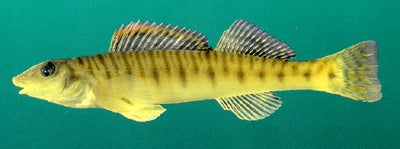SOUTHERN LOGPERCH
SCIENTIFIC NAME: Percina austroperca
CHARACTERISTICS: The southern logperch, one of Alabama’s most recently described darter species (Thompson, 1995), closely resembles two other undescribed logperch species in the state, the “Mobile logperch” and the “Gulf logperch” (Thompson, 1985). Percina austroperca is distinguished from other logperch by a thin red submarginal band in the spiny dorsal fin, by an entirely scaled nape, by absence of scales on top of the head and the anterior part of the breast, and by having no preopercle blotch on adults. Its lateral banding pattern consists of nine vertically elongated bars, separated by a series of thin, short vertical bars. The anterior elongate bars are slightly widened into blotches. Percina austroperca has higher anal ray and pored lateral line counts than the “Gulf logperch,” which it mostly closely resembles. In contrast to the southern logperch, vertically elongated bars along the sides of the “Mobile logperch” are expanded into blotches below the lateral line, and are individually separated by shorter bars that are not expanded at the lower ends.
ADULT SIZE: 3.1 to 5.3 in (80 to 135 mm)
DISTRIBUTION: The southern logperch is known from the Choctawhatchee and Conecuh river drainages in Alabama and Florida. We collected the only two records from the lower Choctawhatchee River system in Alabama and most of the records in the Conecuh River system, where the species is more widespread. This logperch is known only from these two drainages and is allopatric with all other logperch.
HABITAT AND BIOLOGY: The southern logperch prefers large rivers and streams with shifting sand and gravel substrates. Large numbers have been observed in the main channel of the Conecuh River over shoals two to three feet deep. Little else is known about the biology of this species, although its diet is presumably similar to that of other logperches, consisting of aquatic insect larvae. Our observations indicated that southern logperch spawn early in the year, as do other logperch in the subgenus Percina. This and other logperch species are known to flip stones or similar objects scattered along the bottom in search of food. With age, their snouts often become blunt and somewhat calloused.
ORGINAL DESCRIPTION: Thompson described the southern logperch in 1995.
ETYMOLOGY:
Percina is a diminutive of Perca, meaning perch.
Austroperca means southern perch, referring to the southern extent of its distribution.
The copyrighted information above is from Fishes of Alabama and the Mobile Basin.






